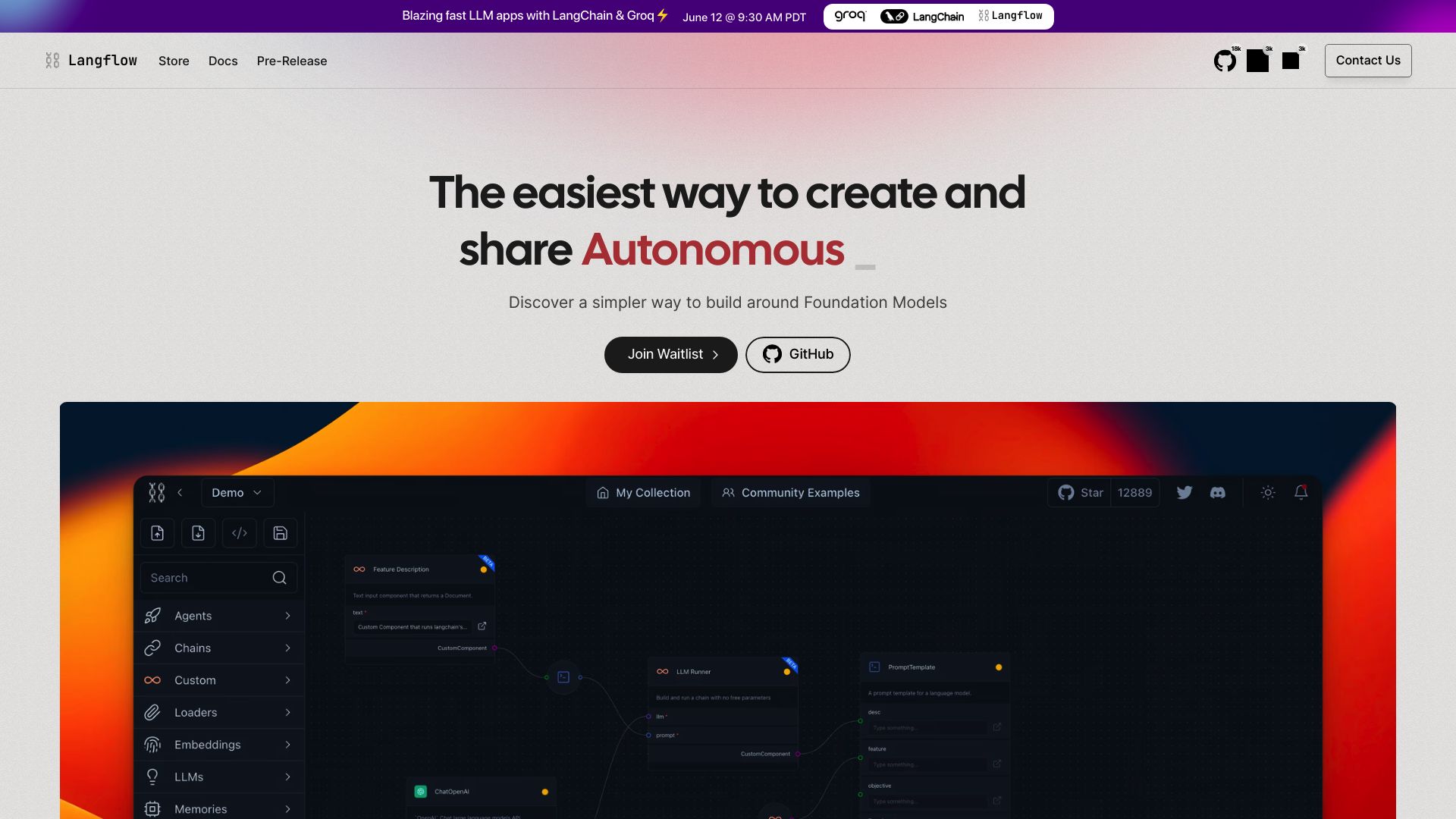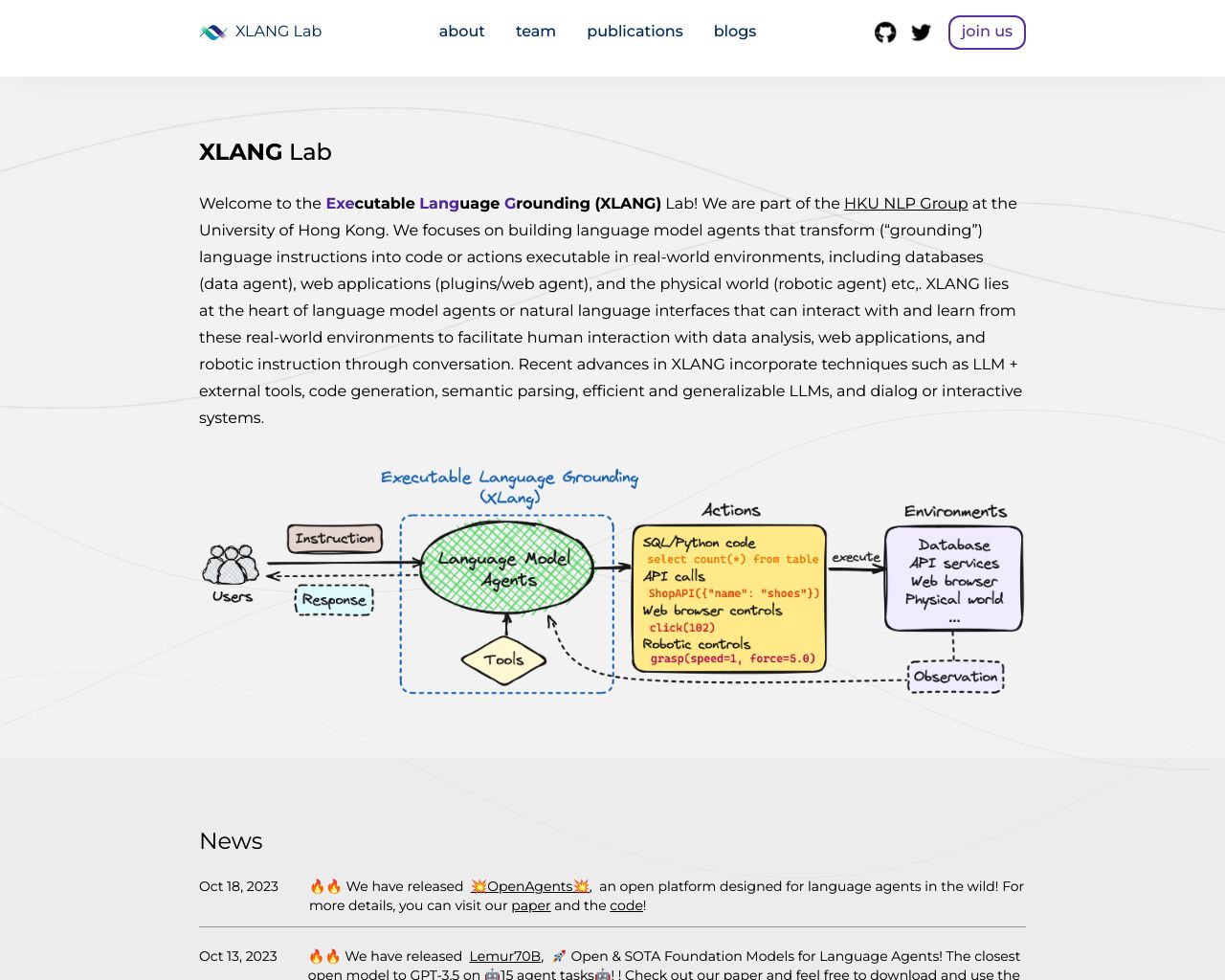Langflow vs. OpenAgents: Comparing AI Development Platforms
AI agent development platforms empower users to harness cutting-edge technology for diverse applications. Langflow vs. OpenAgents stand out in this space, each offering unique approaches to AI integration. Langflow’s visual builder simplifies complex workflow creation, while OpenAgents specializes in data analysis, plugin integration, and web browsing.
This comparison explores their key features, strengths, and limitations, revealing how they stack up against SmythOS, our comprehensive AI development solution. Whether you’re a developer seeking powerful customization tools, a business leader focused on scalability and security, or an AI enthusiast exploring new possibilities, this analysis will guide you in choosing the right platform for your AI journey.
Langflow Overview
Langflow empowers users to build AI-powered workflows without extensive coding. This open-source platform simplifies the creation of complex AI applications through its intuitive visual interface.


Langflow’s drag-and-drop canvas allows users to connect pre-built LangChain components, creating sophisticated AI workflows. The platform supports a wide range of AI agents, including CSVAgent, JSONAgent, and VectorStoreAgent, enabling diverse task execution. Developers can leverage these tools to build chatbots, automate data analysis, and create intelligent assistants.
Langflow empowers users to build AI-powered workflows without extensive coding. This open-source platform simplifies the creation of complex AI applications through its intuitive visual interface.
The platform shines in its flexibility, supporting both local installations and cloud deployments through HuggingFace Spaces. This versatility makes Langflow suitable for individual developers and enterprise teams alike. The built-in chat interface and embeddable widgets facilitate seamless integration of AI conversations into existing applications.
Langflow’s emphasis on customization sets it apart. Users can create bespoke components using Python scripts, tailoring the platform to specific needs. This feature, combined with the visual builder, strikes a balance between accessibility and advanced functionality.
While Langflow offers a low-code approach, it may present a learning curve for those entirely new to AI concepts. The platform’s scalability for large-scale deployments and complex workflows remains an area for consideration. Despite these potential limitations, Langflow’s combination of visual tools, customization options, and integration capabilities positions it as a valuable asset for teams looking to harness AI without deep technical expertise.
OpenAgents Overview
OpenAgents offers a versatile platform for integrating voice agents into everyday life. The system revolves around three primary agents: Data Agent for complex data analysis, Plugins Agent with over 200 integrated tools for various tasks, and Web Agent for autonomous web browsing.
The Data Agent excels in processing large datasets, generating insights crucial for roles like marketing. The Plugins Agent stands out with its extensive integration of over 200 plugins, adapting to diverse user needs from weather checks to online shopping. The Web Agent, utilizing a Chrome extension, streamlines internet navigation by automating browsing and exploration.
OpenAgents offers a versatile platform for integrating voice agents into everyday life. The system revolves around three primary agents: Data Agent for complex data analysis, Plugins Agent with over 200 integrated tools for various tasks, and Web Agent for autonomous web browsing.


OpenAgents emphasizes user-friendliness with a web UI and backend server, making it accessible to non-expert users. The platform supports deployment on localhost and allows for the integration of new agents and plugins, enhancing its adaptability. This flexibility caters to a wide range of users, from data analysts to everyday consumers seeking automated assistance.
OpenAgents emphasizes user-friendliness with a web UI and backend server, making it accessible to non-expert users. The platform supports deployment on localhost and allows for the integration of new agents and plugins…
However, OpenAgents faces challenges in areas like multimodal capabilities and scheduled agent deployment. The platform lacks explicit support for processing both text and images simultaneously, potentially limiting its application in scenarios requiring diverse input types. Additionally, the absence of a built-in scheduler for agent work may hinder users needing automated, time-based task execution.
Despite these limitations, OpenAgents’ vision of creating an open platform that integrates language agents into daily life positions it as a promising tool in the AI landscape. By bridging the gap between expert and non-expert users, OpenAgents aims to provide practical solutions for real-world challenges, making AI and language agents more accessible and useful in everyday contexts.
Feature Comparison
Langflow and OpenAgents offer distinct approaches to AI agent development, with notable differences in their core components and security features. Langflow excels in providing a visual builder with drag-and-drop functionality, enabling users to create complex AI workflows without extensive coding. Its integration with LangChain components and support for various AI models gives developers flexibility in crafting tailored solutions. OpenAgents, on the other hand, focuses on specialized agents for data analysis, plugin integration, and web browsing, catering to specific use cases with pre-built functionalities.
In terms of security, Langflow emphasizes data protection through environment variables and secure deployment configurations. However, it lacks explicit features for constrained alignment or IP control. OpenAgents’ security measures are not prominently highlighted in the available information, potentially indicating a gap in robust security features compared to more enterprise-focused platforms.
While both platforms aim to simplify AI agent creation, they diverge in their approach to scalability and deployment options. Langflow offers flexibility in deployment, supporting both local installations and cloud-based solutions through HuggingFace Spaces. OpenAgents, with its focus on voice agents and everyday tasks, may have limitations in large-scale enterprise deployments or complex workflow integrations. This contrast underscores the importance of choosing a platform that aligns with specific project requirements and scalability needs.
Feature Comparison Table
| Langflow | OpenAgents | SmythOS | |
|---|---|---|---|
| CORE FEATURES | |||
| Visual Builder | ✅ | ❌ | ✅ |
| No-Code Options | ✅ | ❌ | ✅ |
| Problem-Solving Capabilities | ❌ | ✅ | ✅ |
| Work as Team | ❌ | ✅ | ✅ |
| Bulk Work | ❌ | ✅ | ✅ |
| Agent Work Scheduler | ❌ | ❌ | ✅ |
| SECURITY | |||
| Constrained Alignment | ✅ | ❌ | ✅ |
| Data Encryption | ❌ | ✅ | ✅ |
| IP Control | ❌ | ❌ | ✅ |
| COMPONENTS | |||
| Foundation AIs | ❌ | ✅ | ✅ |
| All other APIs, RPA | ❌ | ✅ | ✅ |
| Data Lakes | ✅ | ❌ | ✅ |
| DEPLOYMENT OPTIONS (EMBODIMENTS) | |||
| Deploy as API | ❌ | ✅ | ✅ |
| Staging Domains | ✅ | ❌ | ✅ |
| Production Domains | ❌ | ❌ | ✅ |
| API Authentication (OAuth + Key) | ❌ | ✅ | ✅ |
| Deploy as Site Chat | ❌ | ✅ | ✅ |
| Deploy as Scheduled Agent | ✅ | ❌ | ✅ |
| Deploy as GPT | ❌ | ✅ | ✅ |
| DATA LAKE SUPPORT | |||
| Hosted Vector Database | ✅ | ❌ | ✅ |
| Sitemap Crawler | ❌ | ❌ | ✅ |
| YouTube Transcript Crawler | ❌ | ❌ | ✅ |
| URL Crawler | ❌ | ✅ | ✅ |
| PDF Support | ❌ | ✅ | ✅ |
Best Alternative to Langflow and OpenAgents
SmythOS stands out as the superior alternative to Langflow and OpenAgents, offering a comprehensive platform for AI agent development and deployment. Our solution combines powerful features with user-friendly design, making it ideal for both technical and non-technical users.
We provide a robust visual builder that surpasses Langflow’s drag-and-drop interface, allowing users to create complex AI workflows effortlessly. Unlike OpenAgents’ limited focus on specific agent types, our platform supports a wide range of AI applications, from chatbots to data analysis tools.
SmythOS excels in scalability and deployment options, addressing limitations found in both Langflow and OpenAgents. We offer seamless integration with various environments…
SmythOS excels in scalability and deployment options, addressing limitations found in both Langflow and OpenAgents. We offer seamless integration with various environments, including development and production servers, ensuring smooth transitions from testing to live deployment. Our platform supports deployment as APIs, webhooks, site chats, and even as GPT models, providing flexibility that neither Langflow nor OpenAgents can match.
Security is a top priority for SmythOS. We implement robust features like constrained alignment, data encryption, and IP control, surpassing the security measures of both Langflow and OpenAgents. This makes our platform ideal for enterprises dealing with sensitive data and complex regulatory requirements.
With SmythOS, users gain access to a comprehensive suite of AI capabilities, including foundation models, API integrations, and advanced data handling features. Our platform’s versatility enables the creation of sophisticated AI agents capable of tackling a wide array of business challenges, far exceeding the specialized focus of OpenAgents or the limited integrations of Langflow.
Conclusion
Langflow and OpenAgents offer unique approaches to AI agent development, each with distinct strengths. Langflow excels with its visual builder and LangChain integration, while OpenAgents specializes in data analysis, plugin integration, and web browsing. However, both platforms have limitations in scalability and advanced security features that may not meet enterprise-level demands.
SmythOS emerges as the superior choice, addressing the limitations of both Langflow and OpenAgents while offering a comprehensive suite of features. Our platform’s drag-and-drop interface rivals Langflow’s ease of use, while our extensive integration ecosystem surpasses OpenAgents’ plugin offerings. SmythOS supports multimodal interactions, problem-solving capabilities, and scalable deployments as APIs, chatbots, and scheduled agents.
Unlike its competitors, SmythOS prioritizes enterprise-grade security with features like constrained alignment, data encryption, and IP control. We also offer unparalleled flexibility in deployment options, from staging environments to production domains, ensuring seamless integration into existing workflows.
For those ready to experience the future of AI agent development, we invite you to create a free SmythOS account. Explore our diverse range of AI-powered agent templates and deploy AI agents anywhere with our versatile platform. SmythOS empowers you to build, deploy, and scale AI solutions with unprecedented ease and efficiency.
Last updated:
Disclaimer: The information presented in this article is for general informational purposes only and is provided as is. While we strive to keep the content up-to-date and accurate, we make no representations or warranties of any kind, express or implied, about the completeness, accuracy, reliability, suitability, or availability of the information contained in this article.
Any reliance you place on such information is strictly at your own risk. We reserve the right to make additions, deletions, or modifications to the contents of this article at any time without prior notice.
In no event will we be liable for any loss or damage including without limitation, indirect or consequential loss or damage, or any loss or damage whatsoever arising from loss of data, profits, or any other loss not specified herein arising out of, or in connection with, the use of this article.
Despite our best efforts, this article may contain oversights, errors, or omissions. If you notice any inaccuracies or have concerns about the content, please report them through our content feedback form. Your input helps us maintain the quality and reliability of our information.
